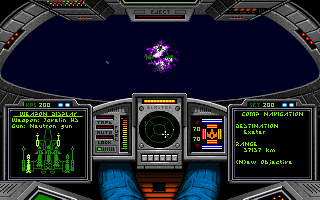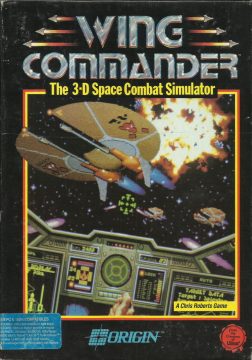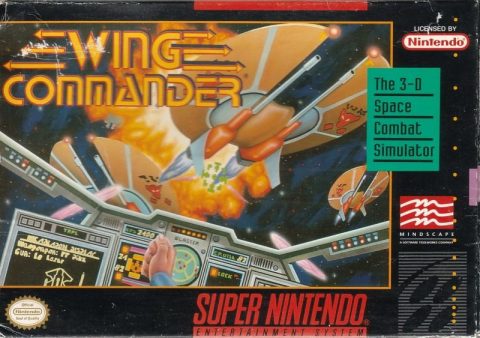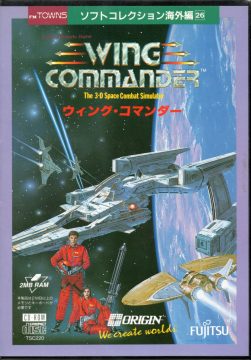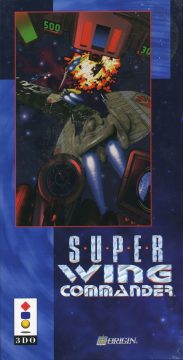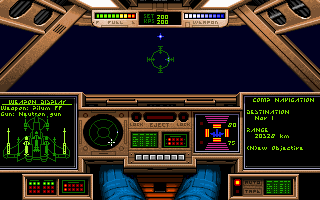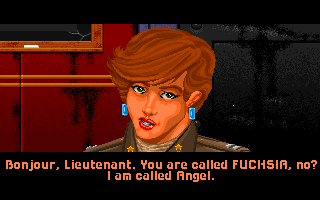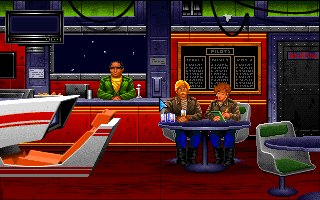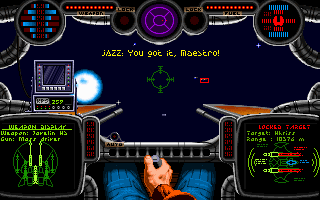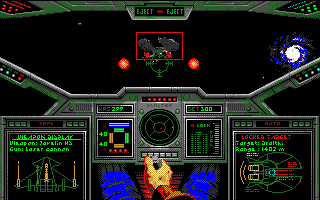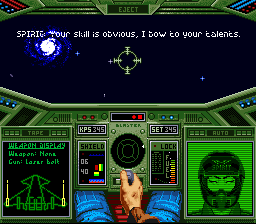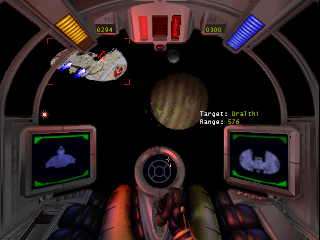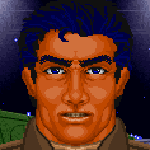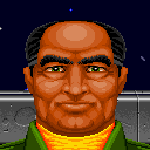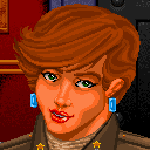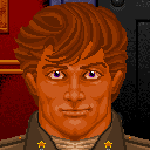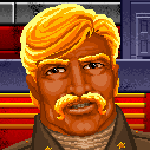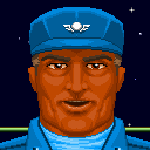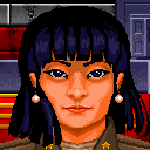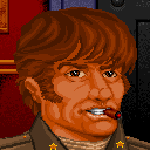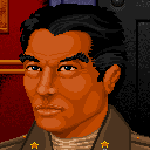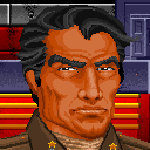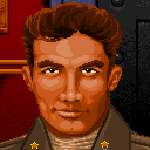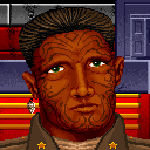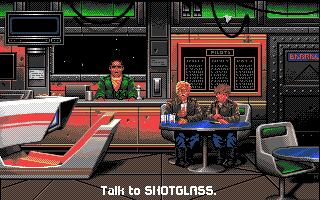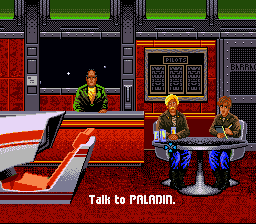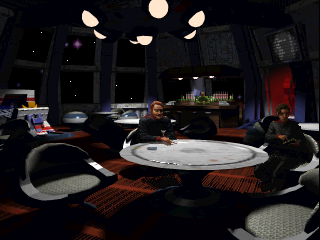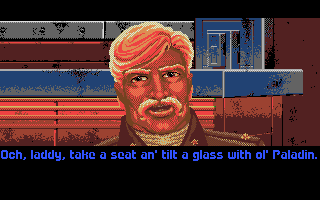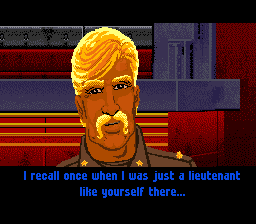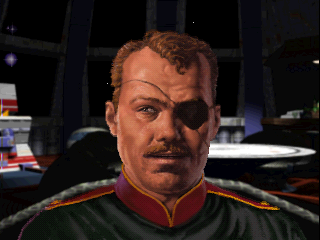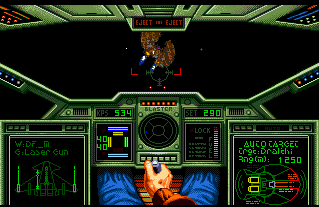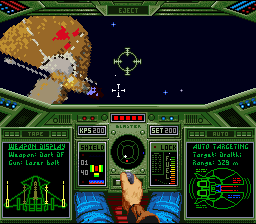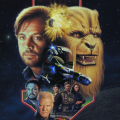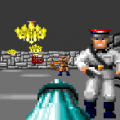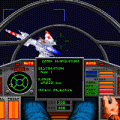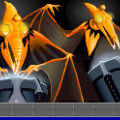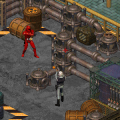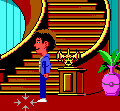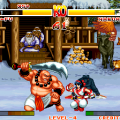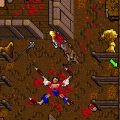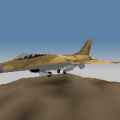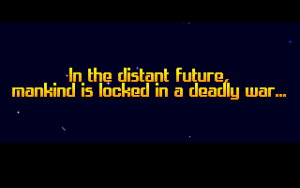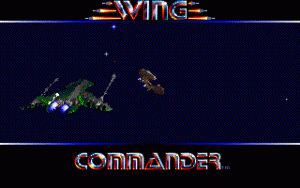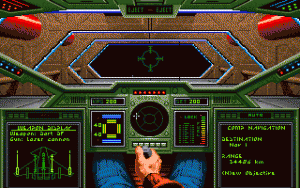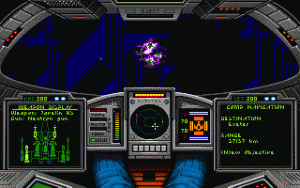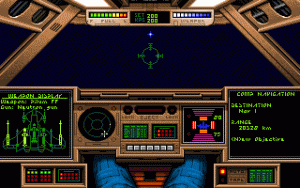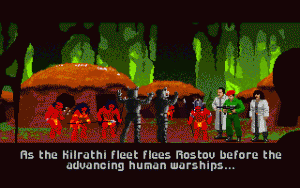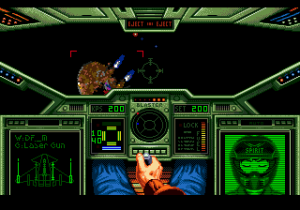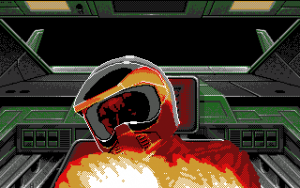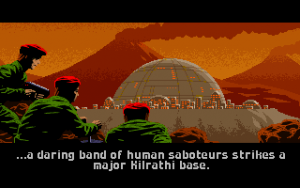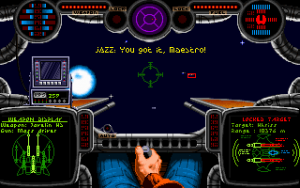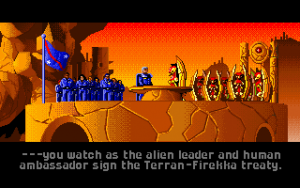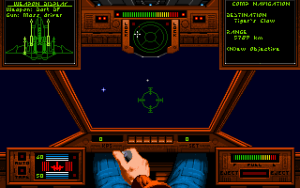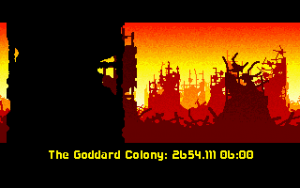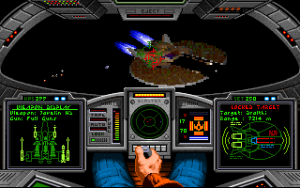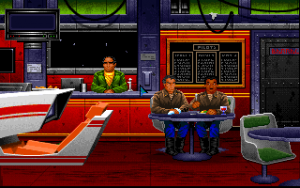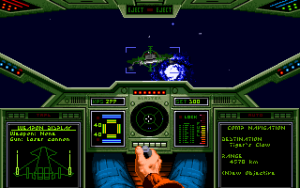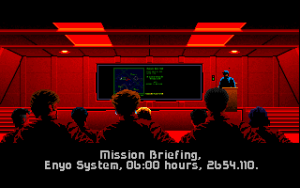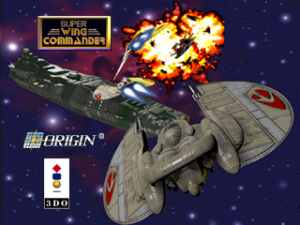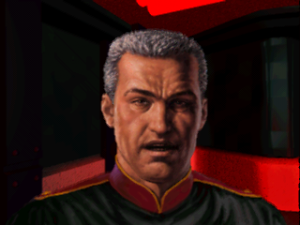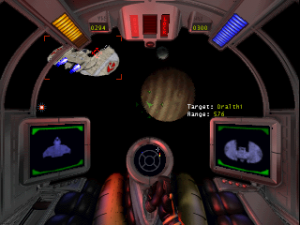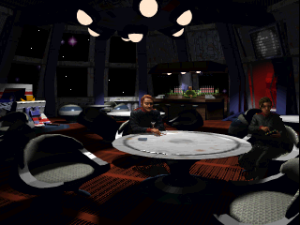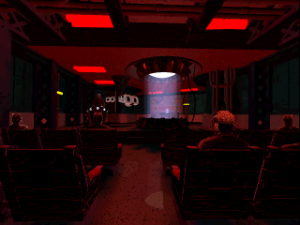‘In the distant future, mankind is locked in a deadly war…’
As Kilrathi fighters fly past, laser bolts shoot past and one explodes into little pieces. Its enemy, a triumphant Earth fighter, turns away while giving the player a good view of its design. As the score soars, the title comes into view: WING COMMANDER. You are a nameless 2nd Lieutenant in the Terran Confederation Space Force. Your mission: save humanity from the evil claws of the Kilrathi Empire!
It’s not an understatement to say Wing Commander looked like nothing else at the time, for many reasons. Its clearly defined storyline, characters, and cutscenes rivaled the most ambitious RPGs in the market. While a space sim, it emphasized quick reflexes instead of exploration, as well as tactically deploying your wingman. Add the most sweeping, military-symphonic score your MIDI-enabled sound card could muster, and a branching mission system, beautifully rendered ship interiors, a performance-based promotion system, a box packed full of lore-heavy literature, ship blueprints, and — you get the picture. The game was presented as a prestige product, showing that Origin was betting big on Wing Commander. And the bet paid off.
In 1990, polygonal graphics were still in their infancy, as evidenced by many contemporary space sims such as Warhead. Wing Commander’s detailed, scaling sprite art was certainly eye-catching, if reliant on older technology. Each ship would be made up of a series of 2D sprite images that would change depending on the angle at which they were being seen by the player, and would scale according to distance. This allowed for colorful, detailed ship models that contributed to a more cinematic look and feel, and save on processing power and development time. Of course, the look wasn’t perfect or smooth, as the ship sprites popped between one view and the other in ways that now can seem incredibly awkward. Plus during gameplay, most of the screen is taken up by the cockpit and its various radars and gauges, so the view window is quite small. At the time, however, that level of detail was unheard of. So much so, that it blew away Origin management when Roberts and Loubet showed them a prototype of the game, which they had been working on when not on office hours. They greenlit it on the spot, with a potential release date of 1990. Granted, the cover art is a bullshot – the sprites are not nearly as high resolution – but it’s still very impressive for the time.
Origin was already trying to diversify from its RPG roots with titles like Space Rogue, a game much more directly influenced by Elite. Squadron, on the other hand, would be a cinematic experience with a developed storyline and character interactions, right down to the choice to give the player a wingman they could issue orders to in combat. By this point, the title had shifted to Wingleader, to more accurately reflect the player’s position commanding a wingman. Closer to release, however, legal difficulties in securing that title led the team to go for their second option, Wing Commander.
With most of the staff in place, music composition duties were given to George “The Fat Man” Sanger, a prolific game musician at the time. While limited to the computer’s MIDI capabilities, it’s quite engaging. Tracks play dynamically based on the action, transitioning from peaceful music when flying about to more intense pieces when entering combat, with a brief victory tune played when a fighter is destroyed.
Each mission is presented with an animated cutscene where your commander breaks down the mission goals and assigns a wingman. Then there’s another cinema of the pilots running to the hangar and hopping into their ships. The mission proper begins when it shifts to a first person perspective and you launch from the ship. Other cutscenes also pop up every so often to show the greater events of the war. The death sequences are particularly brutal – if your ship is destroyed, the scene shifts to cockpit view showing your pilot as he’s engulfed in lights before the ship explodes, then moving to a funeral scene where you’re given a salute and your coffin is launched into space, Star Trek-style. You can eject to fight another day, though if you’re in enemy space, you may be captured by the Kilrathi, after which you’re beheaded.
There are a handful of mission types, almost of which involve moving to certain waypoints, killing all of the enemies, then moving onto the next. You can manually fly between them if you want, though it’s much easier to just use your autopilot to skip to the next area, which is accompanied by a nice little cutscene of you and your wingman flying off together. There are occasionally asteroid fields to navigate through, which are an immense pain, because hitting one can severely damage if not destroy your ship outright. Occasionally there are escort missions, where you need to protect some largely defenseless ship from enemy attack, as well as occasional fights against enemy capital ships. You can command your wingman to attack different targets, and can even taunt enemies in an attempt to draw their fire. Performing well in combat will earn you medals and promotions, though these don’t directly affect the story.
There are four fighter ships you can pilot, each assigned to you for a given mission, and differ in shields, armor, maneuverability, and weaponry. Shields surround the four sides of your ship, and they slowly regenerate after being hit. Your armor does not, though, and taking too many hits will not only affect your systems and weapons but will eventually destroy your ship. Your main weapons are energy based, including the lasers, mass drivers, and neutron guns, the main difference between them being their maximum range and their damage output. Missiles are limited, and there are a few different kinds, some of which are just lobbed forward directly (and are really only useful for taking down large targets like capital ships) and others can home in on enemy (or even friendly) targets with varying degrees of success. While it does use plenty of keys on the keyboard for switching weapons, bringing up targeting systems, communicating with other ships, and so forth, owing to its arcade-y nature, it’s much more approachable than the average flight sim of the era.
On the storyline aspect, Roberts was assigned Jeff George as a writer, who joined Origin following his friend Warren Spector. Spector was co-producing Wing Commander, seeking to bring the freer interactive narratives he had worked on in tabletop games, and felt George was a good fit for the project. Roberts pushed for a morally complex storyline, with shades of gray illustrated by character choice, a design principle he would continue to strive for in future installments. George, however, felt a more simplistic approach would fit the space combat game better. He altered certain aspects of the setting, such as replacing the name of humanity’s spacefaring body from the Empire of Humanity to the Terran Confederation. George felt sci-fi audiences would, logically, associate the word ‘Empire’ with an evil organisation, which would not have fit his more straightforward take on the story. In his view, lacking these moral gray areas helped players in being fully immersed in the world and simulation, rather than overly worrying about the moral implications of their actions.
As mentioned above, the boxed PC game included several goodies, as was common for big box PC game releases of the time. Chief among these was Claw Marks, a lore and gameplay booklet masquerading as the in-universe, onboard magazine of the player’s home carrier. Written completely in character and edited by various officers conspicuously sharing the names of the game’s staff, the magazine provided combat strategies, personnel profiles, and important information on the current state of the universe and the conflict with the Kilrathi. While not required to understand the game, it helped fleshed out its world significantly.
The first Wing Commander’s storyline is, admittedly, much more basic than future installments. The fact that a game not in the adventure or RPG genres had any sort of characterization and storytelling to this level, no matter how two-dimensional, was innovation enough. Essentially, the player flies missions of a few distinct types: patrol, search-and-destroy, and escort. Every few missions, the player’s carrier, the TCS Tiger’s Claw, will jump to another star system, which the game would pick based on your performance.
Between missions, you can chat with your fellow pilots, your commanding officer, and even the ship’s bartender. Characters shared piloting strategies, commented on the campaign, and tell you of Kilrathi aces to watch out for. While the cast features many distinct personalities, there is a pervading sense of ethnic stereotyping: Scottish pilot Paladin speaks in what one can only call ‘Hollywood Scots’ peppering ‘laddie’ in every sentence; Japanese pilot Spirit adds honorifics to most names and speaks a lot about honor. As one-note as they can be, you at least get a sense for them as people, which, per Roberts design, helped involve you more in the game’s world by making you care about the survival of your wingmen. And yes, they can die, complete with in-game funerals. Obviously, this means they won’t be available for subsequent missions, though the story cycles through them with each series, so you may get a fresh one.
This immersion in a game’s world was practically unheard of in other space simulators of the time, and the talent on display from Origin’s art department betrays their RPG roots. The animated character portraits are incredibly detailed, with many hours of testing spent to make sure the mouth movements were realistic to each line. While the player can’t make any dialogue choices, there’s another role-playing element which contributed to immersion: the branching mission system.
Roberts wanted to avoid the common practice of players exploiting save games repeatedly until they got a mission right. He saw this as breaking the spell of a game’s interactivity, by laying bare the underlying mechanisms of his program. As a solution, the team developed a system in which the only way to lose and stop all progression was to die in a mission. Aside from that, all missions could be completed whether the player had succeeded or failed, leading to a branching storyline. Win most missions, and you’re on the ‘win’ track. Losing puts you on a different track that you can always recover from with enough victories. There are 13 “series” altogether, for a total of 40 missions.
This non-linear, if heavily-guided approach, made for a world that was changing based on player action, perhaps a bit too much. The entire course of the Earth-Kilrathi conflict seems to rest on the triumphs or failures of a single carrier, and a single pilot. Later games would excuse this due to the operations in question being more vital to the war effort, and the player being in a higher-ranking position. On the gameplay side, the branching missions have some balancing problems, too: the losing track punished players with harder missions, despite the fact that getting to that track in the first place might be due to a player’s lack of skill, which would leave them unprepared for even tougher challenges.
All of these features, with the visible care and detail that went into them, naturally made the game stand out. The sheer variety of features was, in fact, a result of Chris Roberts’ approach of incorporating every interesting suggestion or idea the team came up with. Roberts was co-producing the game with another Origin newcomer, Warren Spector. Spector had a knack for understanding a director’s vision and pushing for a more cinematic, immersive feel in games, and he respected Roberts’ creativity.
Spector was, unfortunately, not very good at reining in Roberts’ tendency to keep adding to the feature list, also known as ‘feature creep;. This resulted in Roberts being removed from co-producing duties, replaced by Executive Producer Dallas Snell. Roberts was now ‘just’ tasked with Direction, which included a significant amount of programming in those days. Snell was the ‘get-it-done’ man in Origin, the man who believed in the company’s projects but with a grounded, realistic approach to managing them. He said others saw him as the ‘ogre’ that killed the fun when things were getting out of hand, but his no-nonsense approach at making sure projects were delivered at all made him an important part of Origin.
While clearly superseded by future installments, the first Wing Commander is still a fun, if frustrating, experience. The game doesn’t scale very well to different processor speeds, and playing it on modern system is a matter of constantly juggling the CPU cycles to get the ‘sweet spot’ that will make the game run adequately. It’s still engaging, but can leave a modern player banging her head in frustration after an asteroid comes out of nowhere and, in less than a second, pulverizes her plane.
Back in 1990, however, the gaming public responded enthusiastically to the game’s release. The space simulator proved a hit for Origin, with Roberts being heard quoting over 100,000 units sold, which sounds unrealistic for the time (and no detailed breakdowns of the series’ sales figures have ever been published aside from vague lifetime sales of the franchise). What we do know, is that Wing Commander took the gaming world by storm with its exciting gameplay, immersive storyline and by pushing the envelope for PC games. Expansion packs quickly followed, acting as sequels to the core game’s Vega Campaign.
Ports and Expansions
Both mission packs contained 16 new missions, and new enemy ships to fight. The packs eschewed the branching system: failing any mission set would send the player to the bad ending scenario. This complemented the increased difficulty level, aiming to provoke uneasiness in the player due to the covert, behind-the-lines nature of the two add-ons. Both of the mission packs allow the player to transfer their save file, keeping their record, medals and kill scores.
The first Secret Missions expansion arrived in late 1990. It focused on the hunt for the Kilrathi dreadnought Sivar, equipped with a lethal superweapon, the Graviton Gun, which is capable of destroying entire population centers in a single shot. The Tiger’s Claw leaves the Vega Sector responding to a distress call from Goddard colony, but arrives too late to prevent its destruction. Eventually victorious over the Sivar, the ending sees its commander executed. Later fiction would indicate this was the Crown Prince of the Kilrathi. This connected it to the second mission pack, in which the new Crown Prince, Thrakhath, menaces the Tiger’s Claw.
Said pack, Secret Missions 2: Crusade, followed in April 1991. Developed while Wing Commander II was in its early production stages, the team chose to use the expansion to establish characters that would be seen in the sequel. These included pilots Jazz and Doomsday, as well as Kilrathi Crown Prince Thrakhath (more on them in the Dramatis Personae, below). The story concerns the new alliance between humanity and the Firekkans, an alien race which, like the Kilrathi, are anthropomorphic animals (in this case, humanoid birds). Crusade was written and directed by Ellen Guon Beeman, the first female director in the series, who would become co-director and writer of Wing Commander II, further tying both titles together.
Gameplay-wise, Secret Missions 2 brought a few new features. You could now play any mission from the original Wing Commander at your leisure from the Mission Selector. You also have the opportunity to pilot a Kilrathi Dralthi starfighter, a first for the series, thanks to the defection of a Kilrathi commander you will come to know quite well in Wing Commander II.
The mission packs had managed to keep players hungry for more Wing Commander content quite happy, knowing the sequel was already in development as early as November 1990. Origin was also pleased: they were finally free from being known as ‘the Ultima company’, with another megahit in their hands. Chris Roberts, meanwhile, had started work on a separate project, which would ship as Strike Commander.
But before we jump ahead, let’s look at the ports of the original Wing Commander and its expansion packs.
The first ports to come out were on the Amiga A500 and SNES. The Amiga version is identical to the MS-DOS aside from the reduced color palette, from the original 256-color to a measly 16-color in order to run on more Amiga systems. The port for the Amiga CD32 came in 1993, and restored the 256-color depth, but featured no other changes.
The SNES release, developed by Mindscape, displays at a lower resolution. This version introduced changes typical of Nintendo’s content policies of the time, including removal of references to alcohol and anything sexually suggestive. The port, boldly trying to reproduce a game top-of-the-line PCs were struggling with, had a number of cutbacks. Several UI elements seem to work at lower framerates, with some completely missing, such as the all-important red square around a locked target. The controls work relatively well considering they had to fit a whole keyboard’s worth of commands onto a single controller. The player only ever engages single enemies, as other enemies in the area seem to disappear, probably in an attempt not to overwhelm the SNES with slowdown. The music was converted directly into the SNES’s own format but apparently not adjusted beyond basic conversion from MIDI, and they don’t always sound great. Still, it runs at a consistent, playable speed, which was no mean feat for an early SNES cartridge. The first Secret Missions pack was also ported to the SNES, albeit as a separate cartridge.
After the 1991 release of Wing Commander II and its optional Speech Accessory Pack, many ports would follow suit and incorporate digitized speech in their versions of the first installment. The port for Japanese computer system, FM Towns, added in-flight speech (in Japanese, of course). Another important addition was the switch from MIDI to digital Redbook audio, granting the original composition a more grand, orchestral feel.
In 1994, the game was ported to the Sega CD system by Game Arts. Despite the lower color depth, it looks much closer to the PC version than the SNES game, and now included newly recorded dialogue for both the cutscenes and all of the conversational chats. This meant the player is no longer able to rename the main character, whose name and callsign are both ‘Hotshot’. The music for this version is completely original, most of it using the Sega CD’s strong PCM sampling, so it sounds stronger than the average Genesis soundtrack. It was composed by Two-Five, a music studio who worked on the Lunar games, among others. Unlike Wing Commander II, whose voice cast was made up of Origin staff, the Sega CD port of Wing Commander features professional voice actors, such as the rather ever-present Cam Clarke as Colonel Halcyon. It’s generally well done, but between the low sampling rate and the thick accents, coupled with the lack of subtitles, it can sometimes be hard to understand what’s being said.
As far as gameplay, it’s more authentic than the SNES game, but the speed is also extremely sluggish – it’s much slower than it should be normally, and it absolutely crawls the moment multiple enemies show up on-screen. It actually helps make the game significantly easier since it’s much easier to hit enemies when the whole game is running at a fraction of the intended speed. The ships are also lower resolution than the other versions, making them look like a mess of pixels when up close. The six button controller is supported and makes piloting the ship and commanding your wingman much easier. Overall, this wasn’t a bad compromise for the time, but nowadays the slow speed makes it hard to play. Too much neither the soundtrack nor the voices were used in any other version.
The final port is, perhaps, the most substantial: Super Wing Commander for the Panasonic 3DO, later ported to the Macintosh. The game features an improved engine with higher resolution sprites, possibly the same version of the RealSpace engine later used by Wing Commander: Armada. Not to be confused with the ‘Super’ prefix often added to games on the SNES, Super Wing Commander for the 3DO is a full remake from the ground up. The game features new cutscenes done in a completely different style. The aesthetic has shifted from the pulp-WW2 charm of the original into a more modern, darker military sci-fi look. Characters look completely different, as do all ships (the developers were not given any ship models to work from, or so the story goes).
The cutscene quality has also increased, with the game releasing just as Full Motion Video was becoming popular. Characters are fully voiced, of course, though the cast is much different (and worse) than the Sega CD version. Cutscenes feature much more dynamic CGI battle scenes, closer in aesthetic to Wing Commander III while still retaining its own identity separate from the main series. This unique look for the Wing universe even extended to the frankly ludicrous take-off sequence, in which the player character is fitted with a spacesuit and boards his plane through a variety of strange high-tech contraptions. Edgy ‘90s trappings aside, this version was clearly conceived as a prestige remake, as it includes not only both Secret Missions packs, but a brand new set of missions set between the two. In what fans have dubbed ‘Secret Missions 1.5’, the player must track down the shipyards where the Sivar Dreadnought was constructed.
Origin re-released Wing Commander as a CD-ROM Deluxe Edition for IBM PCs, which included the base game and both mission packs but no other enhancements. It was later re-released in CD-ROM as part of the Kilrathi Saga box set, which included Wing Commander II and III as well, now ported for Windows 95. The Secret Missions add-ons had to be downloaded separately, however. This release allowed the cockpit graphics to be toggled off, providing a more immersive, full-screen experience. The soundtrack was also replaced with digital files, rearranged by Wing Commander III composer, George Oldziey. While the WAV files could be of better audio quality, the arrangements here mostly work and add gravitas to the original compositions. They are not, however, ‘re-orchestrated’ as the box for The Kilrathi Saga claims: these are still synthesised tracks, not recorded with a full orchestra.
More recently, the SNES port of the both the main game and Secret Missions were released as part of the EA Replay compilation for the PlayStation Portable. As of this writing, the DOS version of the game’s Deluxe Edition is available to purchase on GOG.com, and includes both Secret Missions packs as well as the sequel and its own add-ons.
DRAMATIS PERSONAE
You (“Bluehair Ourhero”)
You are a 2nd Lieutenant on the fighter wing of the TCS Tiger’s Claw. You’re fresh out of flight school and eager to prove yourself where it counts: in the cockpit of a Confederation starfighter, fighting the good fight. You have a vague backstory which is not relevant, and will get fleshed out in further prequels, sequels, and ancillary media. Your name and callsign are blank, to be filled in by the player when they start a new game. You have blue hair, and people seem to think you’re neat. I think so too.
Sam, a.k.a. “Shotglass”
The Claw’s bartender-in-residence, Shotglass has recently retired from piloting due to his injuries. His welcoming demeanor makes him a perfect source of advice and information on other pilots, as he’s flown with most of them. He’s clearly served in the space force for a long time, as he has in-depth knowledge of Kilrathi aces, tactics, and even the Kilrathi names for certain systems.
Captain Jeannette “Angel” Deveraux
Angel is your typical by-the-book pilot. She believes in the regulations, because they save lives, and has no time for hotshot arrogance, for she has seen it gets people killed. She’s a native of Belgium, and is respected for her cool-headed aiming skills in even the harshest dogfight. She has a tendency to punctuate her sentences with French, n’e c’est pas?
2nd Lieutenant Todd “Maniac” Marshall
Maniac is exactly the kind of greenhorn hotshot Angel despises. He thinks the rules don’t matter when the enemies have studied our battle tactics, and thinks only by breaking regs will we really get anywhere. A native of Proxima Centauri, he was given his callsign based on his flying style. While Maniac is clearly talented, his risky flying style has earned him scorn from his fellow pilots.
Major James “Paladin” Taggart
Aye laddie, Paladin’s yer pal tae have yer wing since ole times! Paladin is the big brother of the Tiger’s Claw fighter wing thanks to his age and experience. Always friendly with a word of advice about this or that Kilrathi tactic or ace pilot, Paladin has a reputation as a considerate, protective wingman, which resulted in his callsign. He’s also Scottish, och aye. He might look a bit like a young Sean Connery, but we can neither confirm nor deny. Wink wink. A native of the Ares colony in Venusian orbit, Paladin’s family hails originally from Wick, Scotland. And yes, that’s in the Highlands.
Colonel Peter Halcyon
The commander of the TCS Tiger’s Claw’s 88th Fighter Wing, and by extension all of its squadrons. He provides briefings, bestows promotions, medals, and reassigns pilots to different squadrons according to the specs of the mission. A no-nonsense military man, Halcyon had a direct style when it came to dealing with his pilots, praising them for their quick-thinking as strongly as he would berate them for taking unnecessary risks. On the gameplay side, he serves to give you your mission objectives, as well as providing kill counts and damage assessments after you land back at the Claw. He’s the Claw’s captain in The Secret Missions, and in the Super Wing Commander remake. And yes, his position means he, not you, is the game’s titular Wing Commander.
1st Lieutenant Mariko “Spirit” Tanaka
Born in Hokkaido, Japan, Spirit is known for having great combat sense, being able to almost predict enemy movements and use this to her advantage. Her callsign is an interpretation of the moniker her Japanese instructors gave her, ‘kami’, due to this almost supernatural intuition. Claw Marks also describes her as crafty, she talks a lot about honor and… yeah, she’s a bit of a stereotype. However, the same profile mentions that while her father died in a Kilrathi ambush, this has led people to ask if she sees herself as a modern samurai out for revenge. She dismisses this as ridiculous: ‘I’m a military pilot, not a feudal retainer’… and proceeds to explain why it’s important not to forget the warrior’s codes of the past. Sigh.
Captain Ian “Hunter” St. John
Always pictured chomping on a cigar, Hunter is a pilot’s pilot. Daring, bold, with a killcount to match, Hunter chews tobacco in the cockpit to prevent having a dry mouth from the dogfight sweats. Much like Maniac, Hunter doesn’t have much time for regs, but that’s less due to youth and hot-dogging, and more through a commitment to getting the job done. Hunter is a responsible wingman, and would never leave his fellow pilots hanging to pull off a ridiculous stunt. He’s from Brisbane, Australia.
Major Chen “Bossman” Kien
The second-oldest pilot in the Claw’s fighter wing, Bossman is a down-to-earth, responsible leader. Once a youthful loose cannon with the callsign ‘Ripper’, Kien took heed of the fact many younger, less skillful pilots were imitating his seat-of-his-pants flying style… and came back in a coffin. After he began leading by example, others started calling him the Bossman, and it stuck. He’s a married man and, recently, a father to a baby girl. Kien also holds a degree in aeronautical engineering, and hails from Kaohsiung, Taiwan.
Major Michael “Iceman” Casey
This Canadian ace is the definition of ‘cool under fire’, which explains his callsign. Casey is a focused, precise flyer that doesn’t fill up the comms with pointless chatter or shouting. He has honed piloting into an art form, resulting in the highest kill count in the Tiger’s Claw history. He’s just as taciturn when off-duty, to the surprise of many. He has a daughter, Julia, from his first marriage. He’s very obviously based on Clint Eastwood, and relaxes in the Tiger Claw’s mess hall by polishing a handgun.
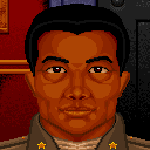
Captain Joseph ”Knight” Khumalo
Often one of the few cool heads in the flight roster, Knight is a decent pilot without any particular specialization. While lacking the manoeuvring wizardry of Hunter, or Maniac’s absurd luck, Knight offers solid backup and reliability. He occasionally makes fun of his fellow pilots when they try to sound tough, and soberly treats piloting like a job, to be fulfilled responsibly. He hails from Kroonstad, South Africa
Lieutenant Zach “Jazz” Colson
A transfer from the TCS Austin, Jazz is another young hotshot eager to prove himself. Much like Maniac, he’s always ready with a quip and a smirk to look down on others. His callsign, Jazz, comes from his talent at playing the piano, and he hails from Kansas City, USA.
Lieutenant Etienne “Doomsday” Monclair
It’s easy to see why his fellow pilots gave Doomsday his callsign. Always the pessimist, Doomsday is convinced he will die in battle soon, and takes care to enumerate the many ways in which a mission could fail. He sees this as realism, however, and believes it’s best to be prepared for the worst outcomes while sipping his favorite strong-brewed coffee. Monclair was born in Aotearoa (New Zealand), and is of Māori descent, wearing traditional tā moko facial tattoos.
Prince Thrakhath nar Kiranka
The Crown Prince of the Kilrathi Empire, after the death of his father Gilkarg. In Secret Missions 2, he leads the Kilrathi crusade against the Firekkans, thirsty for revenge for his father’s disgrace. He eagerly seeks to fulfill the yearly ceremony of the Way of Sivar, for which he pulls numerous fleets towards Firekka. He’s not seen, but transmits a threatening message to the Tiger’s Claw.
Ralgha nar Hhallas
A Kilrathi defector, Ralgha provides intel to ConFed about the Sivar ceremony. He is part of the Ghorah Khar rebellion, made up of Kilrathi lords disillusioned with the many losses taken in the war, and was sent by them to aid ConFed with intel and materiel. This includes his Fralthi capital ship, and a wing of Dralthi fighters. Like Thrakhath, he’s not seen in person.
Vice Admiral Geoffrey Tolwyn
Tolwyn is the unseen ConFed flag officer that orders the Tiger’s Claw to Firekka. He will become a more central character in later installments, and many ancillary media portray him as the commanding officer of the Claw at different points in time.
Screenshot Comparisons
Image Credits
3DO screenshots by AB Silvera
WC1 DOS screenshots by AB Silvera
All cover art from Mobygames
All other screenshots from Mobygames
Character portraits from the Wing Commander Encyclopedia maintained by WCNews: https://www.wcnews.com/wcpedia/Main_Page
